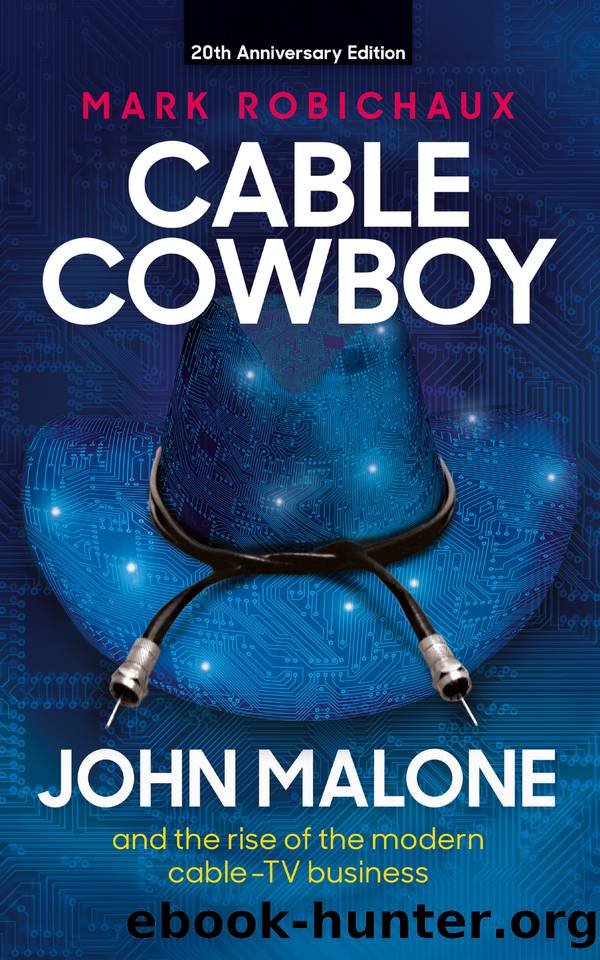Cable Cowboy : John Malone and the rise of the modern cable-TV business by Robichaux Mark

Author:Robichaux, Mark
Language: eng
Format: epub
Publisher: Inshore Publishing
Published: 2023-03-16T00:00:00+00:00
Even as Malone endeavored to defend the Bell Atlantic deal in Washington, he prepared for an extended war on local phone companies across the nation. In December 1993, he led five of the countryâs largest cable TV companies (Tele-Communications, Time Warner, Continental Cablevision, Comcast, and Cox Cable Communications) into a joint venture that would organize local cable operators in large markets to attack one of the Bellsâ most lucrative offerings: service for businesses. Cable operators hoping to offer telephone services on their upgraded lines could be part of an umbrella organization called Teleport. The Teleport partnership proved to be a shrewd way around the telephone companiesâ broad, contiguous regional reach. For example, the Chicago market was served by only one regional telephone company, Ameritech, but 12 different cable operators. This way, local cable operators could share common marketing and advertising, research and development, regulatory advice, and branding of new offerings. âYou donât want 12 different companies trying to position a business against one,â Robert Thomson, a senior vice president of TCI, explained to anyone who wanted to know the rationale. âThis is clearly a step that will enhance competition.â AT&T would end up paying $11.3 billion to buy the company later, netting an average 10-fold gain for the top cable operators, including TCI, whose TCI Ventures received $2.9 billion for its 30 percent stake.8
By early 1994, cable operators were feeling the full brunt of the 1992 Cable Act, no one more than John Malone and TCI, whose stock had fallen nearly 40 percent to the $20 range five months after the Bell Atlantic merger was announced. As far as Wall Street was concerned, the government was kinking the cash flow hose, causing big problems for everyone. In Washington, regulators and congresspeople embarrassed by the first results, in which many consumers actually ended up paying more for cable service, were out for payback. And so in February, the FCC released an overhaul of cable rate rulesâthis one spanning several hundred more pages and complementing the original 500-page order that had gone awry. Replete with a newly fine-tuned formula for setting hundreds of rates, the new, improved model was a basis for arguing cable rates should come down 17 percent, not a mere 10 percent as originally planned.
The economic analysis struck Malone as somewhat convenient: The FCC all but admitted that the second round of rate cuts was necessary by dint of the simple fact that the first round of cuts hadnât brought prices down enoughânever mind that, the first time around, regulators had spent 500 pages devising a 10 percent rollback. If they were right then, how could they be right nowâand if they were wrong back then, why should anyone trust them to be right this time around? To Malone and other cable barons, it seemed damned unjust: It was changing the rules in the middle of the game. Back in the Arlington, Virginia, offices of Bell Atlantic, Ray Smith was no happier about it. He was glued to C-Span,
Download
This site does not store any files on its server. We only index and link to content provided by other sites. Please contact the content providers to delete copyright contents if any and email us, we'll remove relevant links or contents immediately.
Bad Blood by John Carreyrou(6552)
Rich Dad Poor Dad by Robert T. Kiyosaki(6401)
Principles: Life and Work by Ray Dalio(6209)
Playing to Win_ How Strategy Really Works by A.G. Lafley & Roger L. Martin(5917)
Management Strategies for the Cloud Revolution: How Cloud Computing Is Transforming Business and Why You Can't Afford to Be Left Behind by Charles Babcock(4527)
The Confidence Code by Katty Kay(4187)
Thinking in Bets by Annie Duke(4152)
American Kingpin by Nick Bilton(3756)
Delivering Happiness by Tony Hsieh(3365)
Project Animal Farm: An Accidental Journey into the Secret World of Farming and the Truth About Our Food by Sonia Faruqi(3177)
The Power of Habit by Charles Duhigg(3059)
The Tyranny of Metrics by Jerry Z. Muller(3000)
Brotopia by Emily Chang(3000)
Mastering Bitcoin: Programming the Open Blockchain by Andreas M. Antonopoulos(2981)
The Marketing Plan Handbook: Develop Big-Picture Marketing Plans for Pennies on the Dollar by Robert W. Bly(2975)
I Live in the Future & Here's How It Works by Nick Bilton(2935)
The Content Trap by Bharat Anand(2860)
Building a StoryBrand by Donald Miller(2841)
Applied Empathy by Michael Ventura(2839)
